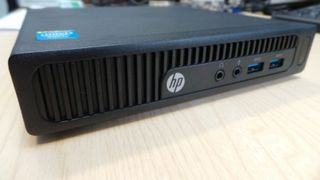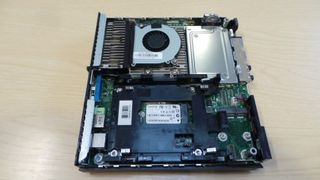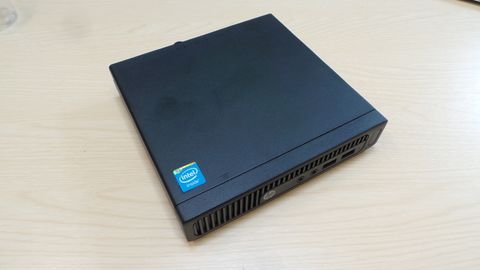TechRadar Verdict
The HP 260 G1 should be high on your list if you're looking for an affordable yet capable computer that can deliver the goods in terms of light workloads. It will be equally capable in the enterprise or at home.
Pros
- +
The price
- +
Better than expected performance
- +
Two memory slots
- +
DisplayPort and VGA
- +
Full Windows
Cons
- -
No Wi-Fi or Bluetooth
- -
Lack of storage capacity
- -
Low amount of system memory
Why you can trust TechRadar
Sometimes, a PC vendor comes up with something totally unexpected that, well, gets heads turning. That's a fairly easy thing to achieve in a market that has relied for years on flogging the same boxes or base units to avid audiences. Now users are shifting elsewhere (to tablets, laptops, all-in-ones), leaving the aforementioned vendors with no way forward other than innovating.
Which brings me nicely to the HP 260 G1 (manufacturer ID K8L27EA#ABU). As its suffix alludes to, this is a first generation desktop mini PC that's part of the company's business desktop range. It currently is the cheapest ready-to-use Windows computer in the market at just under £100 (around $155, or AU$205) at Ebuyer which provided us with today's sample (we noticed that adding a 3-year Square Trade Warranty will cost only £18, so this is an option worth considering).
The only other rival in this price range is the Lenovo ThinkCenter E50 which we reviewed recently and is a more traditional computer at £120 (around $185, or AU$250). This model is also available with more expensive (and powerful) Core i5 processors.

Design
The first thing you notice when getting the HP 260 G1 delivered is how tiny its box is. Opening it you find a PC that's smaller than a keyboard, along with a traditional keyboard and a mouse. HP deliberately seems to have eschewed the common NUC (next unit of computing) form factor initiated by Intel, for a proprietary one.
At 175mm x 177mm x 34mm and weighing 700g, the 260 G1 is probably one of the lightest fully fledged PCs we've tested, on par with the Pipo X7, though obviously way bigger than the Intel Compute Stick (but the latter is a different beast altogether).
Its targeted market, businesses of all sizes, will love its understated design; the anthracite chassis of the G1 reminds me of an external optical drive.
Its sturdy metal enclosure means that this machine can be easily used as a socle and other than a bundled stand, there's the option of screwing it directly to monitors thanks to a VESA mount.

The front of the device houses the power button, an HP logo, audio ports and two USB 3.0 ports. Flip it around and there's air vents, a VGA and a DisplayPort connector, four USB ports (two 3.0 and two 2.0 ports), a power connector, an audio connector, a security lock and a GbE port. A single screw keeps the compact case closed, a boon for system administrators looking for an easy to dismantle/upgrade computer.
Specification
The HP 260 G1 is powered by an Intel Celeron 2957U; while the mere word Celeron might make a few of our readers snigger, this part shares more in common with another Haswell-based model, the Intel Core i3-4020Y, than it does with the Bay Trail-based Celeron parts that have become ubiquitous. Other than a 1.4GHz clock speed, there are two cores, two threads and 2MB of cache.
The device comes with only 2GB of RAM but can be upgraded to 16GB by swapping the on-board memory for two 8GB SODIMM modules, transforming it into a very capable low cost workstation.
There's also a 32GB M.2 SSD Sandisk storage solution (which can be complemented by a standard 2.5-inch hard drive), Intel HD graphics solution, Windows 8.1 with Bing, sound provided by the Realtek ALC 221 (which supports DTS Sound+ amongst others) and an external 89% efficient 65W power adaptor.

HP has also chosen to bundle applications that some might consider to be irrelevant especially given the low storage capacity of the device – users will probably uninstall Cyberlink PowerDVD 12, Skype, Bing Search, Foxit PhantomPDF, the Weather Channel for HP and Office 365 trial.
The keyboard and the mouse are bog standard, average input devices that do the job as part of HP's value range of products. The keyboard has a row of four multimedia buttons located just above the arrow keys, and both peripherals sport a low-key matte black finish that matches that of the base unit.
The interior of the device is pristinely organised with a DIMM door to protect the memory modules and a carefully aligned heatsink fan (yes, this machine is not fanless).

Performance
When it came to benchmarks, this sub-£100 computer didn't disappoint despite its rock-bottom cost. We were expecting the worst but the HP 260 G1 managed to pleasantly surprise us.
Despite its low price, the G1 managed to score a respectable 14.06 FPS and 101 points on the Cinebench 15 GPU and CPU tests respectively, far higher than its Atom-based peers in the same price range, some of which couldn't even run the tests in the first place.
It achieved 1605, 1997 and 1406 points respectively on the PCMark 8 Home, Work and Creative benchmarks, which again is far higher than similarly-priced Bay Trail desktop systems. The 260 G1 hit 21469, 2075 and 301 on 3DMark Ice Storm, Cloud Gate and Fire Strike, again very decent scores given the price and the intended audience.

Désiré has been musing and writing about technology during a career spanning four decades. He dabbled in website builders and web hosting when DHTML and frames were in vogue and started narrating about the impact of technology on society just before the start of the Y2K hysteria at the turn of the last millennium.

I'm off to France this summer, and this app could make me très fluent

Intel unveils flurry of new Arc GPUs — however serious graphics users will have to wait for more powerful models, as these focus on a completely different and more lucrative market

We just got another hint that the Samsung Galaxy Watch 7 is almost here
